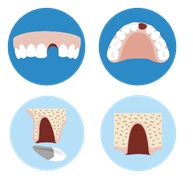Traumatic dental injury. Completely Dislodged Permanent Tooth from the Socket (Avulsion)
In case of avulsion, a permanent tooth completely dislodges from its socket (alveolar bone). The socket of the dislodged tooth may remain empty or fill with blood. This condition requires immediate emergency treatment.
If a tooth dislodges completely, its nerve and blood supply are interrupted, surrounding bone and tissue of the tooth and root surface are damaged.

COMMON CAUSES OF DENTAL AVULSION
- Dental trauma caused by contact and extreme sports. Wear protective mouthguards during contact sports as a prevention.
- accidents related to mobile equipment. Many accidents happen particularly with bicycles, scooters, skateboards, hoverboards;
- unintentional trauma (falling, slipping);
- intentional injuries (impact).
IMMEDIATE ACTIONS AT THE SCENE OF THE ACCIDENT
Find the dislodged tooth at the accident scene. The tooth must be placed back into the mouth within 15-30 minutes in order to prevent subsequent complications.
- Calm the injured person. Assess the extent of the injuries and call an ambulance if necessary.
- Find the tooth. Grasp the tooth with your fingers only from the crown part (the wider part). Do not touch the root surface of the tooth! Carefully rinse the tooth with saline solution, pasteurised milk, or cold water if it is soiled. If these liquids are unavailable, use the victim’s saliva to clean the tooth. Never clean the tooth mechanically or with disinfectants (including alcohol).
- Carefully place the tooth back into its position regardless of possible bleeding.
- Gently place a napkin/gauze between damaged upper and lower teeth and gently bite down to keep the tooth in the correct position.
If immediate tooth replacement is impossible or fails, see a dentist urgently. Until then, the tooth should be kept in a saline solution, pasteurised milk or in the patient’s saliva (in a separate tube or between the teeth and the cheek in the saliva). Never keep the tooth dry or submerged in the water, as this will damage the cells on the root surface of the tooth.
If you do not see a dentist within 60 minutes, the treatment prognosis worsens significantly. It is always necessary to put the tooth back in the mouth, regardless of the time outside the mouth. When the accident happens outside of the appointment hours of dental practice, please go to the emergency department for first aid for maxillo-facial trauma.
Emergency treatment of dental avulsion at the dental clinic
The dentist will perform an examination, and necessary radiographic imaging as well as assess the position of the tooth/teeth, or replace the tooth into its position. The tooth is splinted to the neighbouring teeth. Root canal treatment is performed as necessary (see patient information for Root canal treatment).
FOLLOW-UP APPOINTMENTS AFTER TRAUMA
- 2 weeks after trauma;
- 4 weeks after trauma;
- 6-8 weeks after trauma;
- 3 months after trauma;
- 6 months after trauma;
- one year after trauma and then yearly for the following 5 years.
TREATMENT PROGNOSIS AND POSSIBLE COMPLICATIONS
Treatment of avulsed teeth is usually successful. The prognosis of the tooth depends on the stage of development of the tooth root and the time outside the mouth. The most common complications are necrosis of the pulp (death of the tooth root), root destruction (resorption) or replacement by bone (ankylosis), change in tooth colour or position, and gum recession. Unfortunately, it is not always possible to save your tooth.
Schedule the follow-up visit for the traumatised tooth after the emergency appointment. See your dentist immediately if the replaced tooth becomes sensitive, more mobile, a different colour (pinkish, yellowish, greyish) tooth in your mouth or if gingivitis develops.
HOME CARE AFTER DENTAL TRAUMA
- Kindly avoid sports and physical exercise following the trauma in the mouth.
- Consume soft foods in the next two weeks and avoid biting and chewing on hard substances. It is recommended to chew with the opposite side of the mouth.
- Maintain excellent oral hygiene: brush teeth twice a day with a soft toothbrush and fluoride-containing toothpaste; clean contact surfaces of uninjured teeth with dental floss and interdental brush. As a result of poor oral hygiene, gingivitis may occur and worsen the prognosis of treatment.
- Maintain an excellent oral hygiene: brush teeth twice daily with a soft toothbrush; for the first week perform oral hygiene after each meal.
- Don’t touch the traumatised area with your tongue or fingers.
- Rinse your mouth with chlorhexidine mouthwash twice a day for 1-2 weeks.
- Apply 0,2% chlorhexidine gel on the wound with a clean cotton or gauze pad 2-3 times a day.
- Take over-the-counter analgesics as necessary. Adults: 400 mg to 600 mg of ibuprofen and/or 500 mg to 1000 mg of paracetamol every 6 to 8 hours (or other over-the-counter analgesics). Please note: The pediatric dosage has to be adjusted according to their body weight.
- Antibacterial treatment is indicated for tooth avulsion (completely dislodged tooth from the socket) and soft tissue injuries.
- Check the tetanus immunization status. Update the vaccination, if necessary.
- Schedule the follow-up appointments as the splint should be removed after 2-4 weeks.
If your condition worsens or you have any questions, please contact your dentist or healthcare provider.
Authors: Dr Valeria Hameury, Dr Teele Paltsar, Dr Marjo Sinijärv and Anna Firsova
2023